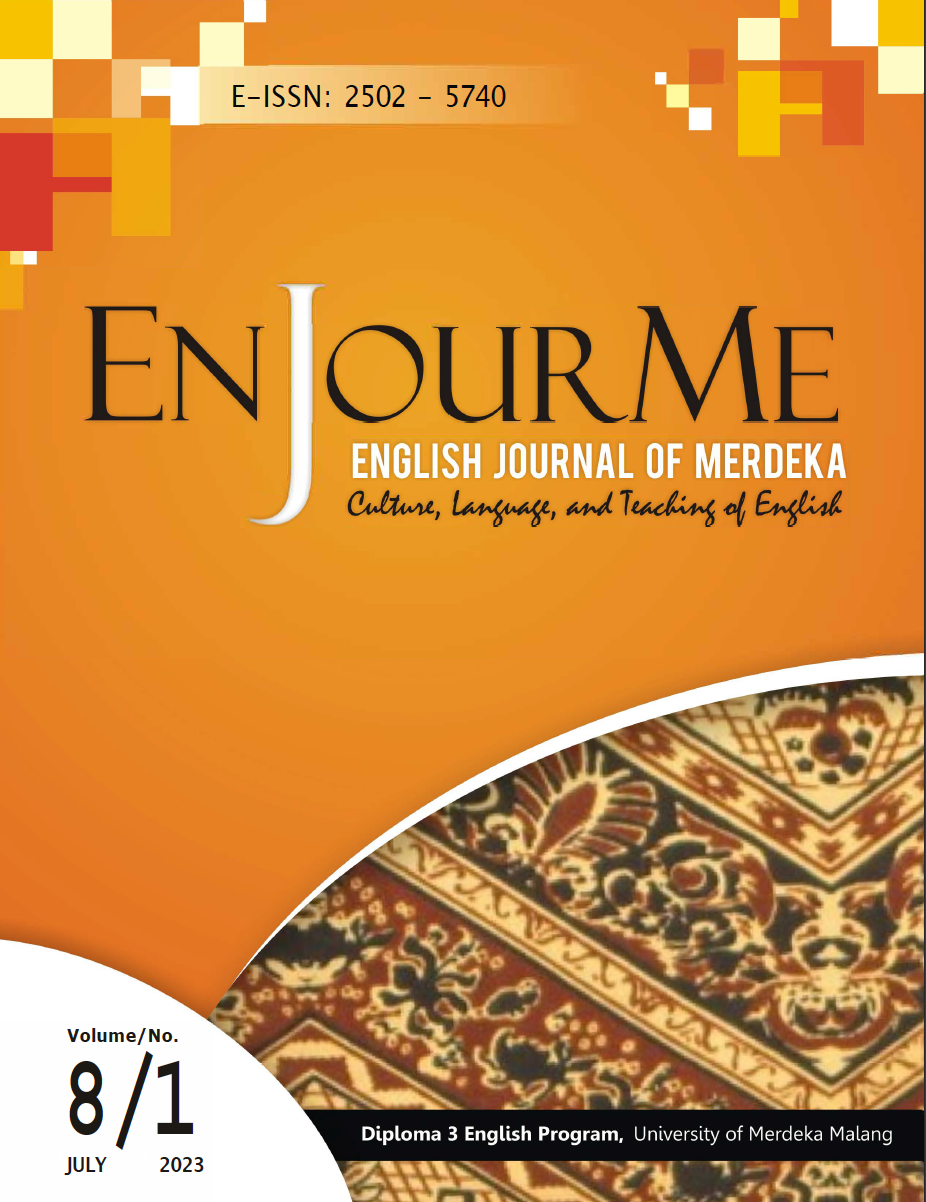Pedagogical implications of figurative language in the movie of Laskar Pelangi: Revisiting the meanings
DOI:
https://doi.org/10.26905/enjourme.v8i1.9973Keywords:
Figurative language, hyperbole, metaphor, movie, literature.Abstract
This study examines the implications of figurative language in the film adaptation of Laskar Pelangi directed by Riri Riza. Laskar Pelangi is a movie based from a novel by Andrea Hirata which was chosen because of positive messages and motivating storyline it has. The method used to conduct this study was descriptive case study. The data source was merely this 124-minute movie of Laskar Pelangi. The data collection was done through documentation by watching the movies several times to find out the figurative languages and the implications conceived. Later, the data were analyzed using interactive analysis involving data reduction, data display, and data verification. The results show that, first, the literary devices of irony, metaphors, simile, hyperbole, and symbolism are employed in the novel "Laskar Pelangi" to accentuate the profound disparity between the aspirations of the students for a more promising tomorrow and the harsh realities of their present existence; second, in terms of pedagogy, figurative language simplifies difficult topics, helps students understand Laskar Pelangi's characters' feelings and analyze word meanings. It also helps students appreciate literature. Conclusively, it can be inferred that Laskar Pelangi holds affirmative and inspiring connotations for its audience, particularly the student demographic.Downloads
References
Al-Qudah, M. (2017). The Jordanian terms of address: Asocio-pragmatic study. SHS Web of Conferences, 37, 1-10.
Bergonzi, B. (1996). Spirituality in modern English literature. Modern English Literature, 18(2): 104-112.
Bogdan, R. C. & Biklen, R.K. (1998). Qualitative Research for Education: A production to theory and method. Boston: Allyin and Bacon.
Brewbaker, J. (2005). Fifty-five teachers, poems in hand, approach the cruelest month. English Journal, 94(4), 18-22.
Dancygier, B., & Sweetser, E. (2015). Figurative Language (review). English Text Construction 8(2), 269-275.
Fadaee, E. (2010). Symbols, metaphors and similes in literature: A case study of Animal Farm. International Journal of English and Literature, 2(2), 19-27.
Fairclough, N. (2005). Discourse analysis in organizational studies: The case for critical realism. Discourse Studies, 5(2): 258–284
Firdous, A., Afzal, T., & Mushtaq, S. (2014). Interdiscursive events misrepresentation in I am Malala: A critical discourse analysis. European Academic Research, 2(5): 6398-6426.
Goatly, A. (2017). The language of metaphors. Routledge.
Hutahuruk, B.S. (2019). The use of figurative languages on the students’ Poetry semester V at FKIP universitas HKBP Nommensen. Journal of English Language and Culture, 9(2), 128-137.
Ismail, N. M., & Moriyanti, M. (2019). The overview analysis of the movie Sense and Sensibility. EduLite: Journal of English Education, Literature and Culture, 4(1), 45-54.
Kövecses, Z. (2017). Where Metaphors Come From: Reconsidering Context in Metaphor. Oxford University Press.
Lakoff, G., & Johnson, M. (2017). Metaphors we live by. University of Chicago Press.
Lismalinda, L., & Ismail, N. M. (202). Figurative language in a translated children’s novel. English Journal Merdeka, 5(2), 125-133.
Miles, M.B, Huberman, A.M, & Saldana, J. (2014). Qualitative Data Analysis. Sage Publications.
Núñez, R. E., & Sweetser, E. (2006). With the future behind them: convergent evidence from Aymara language and gesture in the crosslinguistic comparison of spatial construals of time. Cognitive Science 30(3), 401-425.
Patton, M. Q. (2014). Qualitative Research & Evaluation Methods. Sage Publications.
Rifai, D. M., & Prasetyaningrum, S. T. (2016). A sosiolinguistic analysis of addressing terms used in Tangled movie manuscript. Jurnal Penelitian Humaniora, 17(2), 123-134.
Saldaña, J. (2016). The Coding Manual for Qualitative Researchers. Sage Publications.
Shalihah, M. (2018). A pragmatic analysis on the types and the purposes of address terms used by the main character in Jane Austen’s “EMMAâ€. EnJourMe (English Journal Of Merdeka) : Culture, Language, and Teaching of English, 3(2), 52-60.
Undayasari, D., & Saleh, M. (2018). Comparison of Thematic Structure and Progression between English and Indonesian Exposition Texts Written by Undergraduate Students of UPI (Rhetorical Study). English Education Journal, 8(1), 43-50.
Wibisono, R. T., & Widodo, P. (2019). An analysis of figurative language in online short story posted on the Jakarta Post. Prasasti, 4(2), 156-165.
Yeibo, E. (2012). Figurative Language and Stylistic Function in JP Clark-Bekederemo's Poetry. Journal of Language Teaching & Research, 3(1),180-187.
Additional Files
Published
How to Cite
Issue
Section
License
Authors who publish with this journal agree to the following terms:
(1) Copyright of the published articles will be transferred to the journal as the publisher of the manuscripts. Therefore, the author confirms that the copyright has been managed by the journal.
(2) Publisher of EnJourMe (English Journal of Merdeka) : Culture, Language, and Teaching of English is University of Merdeka Malang.
(3) The copyright follows Creative Commons Attribution–ShareAlike License (CC BY SA): This license allows to Share — copy and redistribute the material in any medium or format, Adapt — remix, transform, and build upon the material, for any purpose, even commercially.




